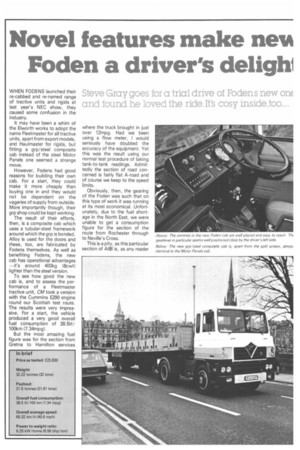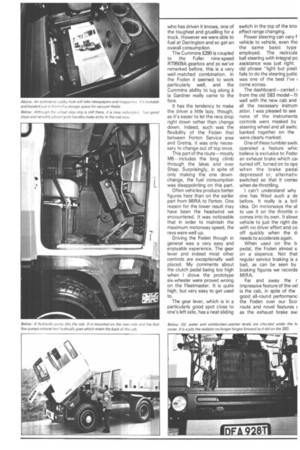Novel features make nevi Foden a driver's delighi
Page 100

Page 101

Page 102

If you've noticed an error in this article please click here to report it so we can fix it.
Steve Gray goes for a trial drive of Fodens new onE and found he loved the ride. It's cosy inside,too....
WHEN FODENS launched their re-cabbed and re-named range of tractive units and rig ids at last year's NEC show, they caused some confusion in the industry.
It may have been a whim of the Elworth works to adopt the name Fleetmaster for all tractive units, apart from export models, and Haulmaster for rigids, but fitting a grp/steel composite cab instead of the steel Motor Panels one seemed a strange move.
However, Fodens had good reasons for building their own cab. For a start, they could make it more cheaply than buying one in and they would not be dependent on the vagaries of supply from outside. More importantly though, their grp shop could be kept working.
The result of their efforts, then, is a composite cab which uses a tubular-steel framework around which the grp is bonded. Alloy is used for the doors and these, too, are fabricated by Fodens themselves. As well as benefiting Fodens, the new cab has operational advantages —it's around 400kg (8cwt) lighter than the steel version.
To see how good the new cab is, and to assess the performance of a Fleetmaster tractive unit, CM took a version with the Cummins E290 engine round our Scottish test route. The results were very impressive. For a start, the vehicle produced a very good overall fuel consumption of 38.5Iit/ 100km (7.34mpg).
But the most amazing fuel figure was for the section from Gretna to Hamilton services where the truck brought in just over 12mpg. Had we been using a flow meter, I would seriously have doubted the accuracy of the equipment. Yet this was the result using our normal test procedure of taking tank-to-tank readings. Admittedly the section of road concerned is fairly flat A-road and of course we keep to the speed limits.
Obviously, then, the gearing of the Foden was such that on this type of work it was running at its most economical. Unfortunately, due to the fuel shortage in the North East, we were unable to get a consumption figure for the section of the route from Rochester through to Neville's Cross.
This is a pity, as this particular section of A68 is, as any reader who has driven it knows, one of the toughest and gruelling for a truck. However we were able to fuel at Da rrington and so get an overall consumption_ The Cummins E290 is coupled to the Fuller nine-speed 1RT9509A gearbox and as we've remarked before, this is a very well-matched combination. In the Foden it seemed to work particularly well, and the Cummins ability to lug along a la Gardner really came to the fore.
It has the tendency to make the driver a little lazy, though, as it's easier to let the revs drop right down rather than change down. Indeed, such was the flexibility of the Foden that between Forton Service area and Gretna, it was only necessary to change out of top once.
This part of the route— mostly M6 — includes the long climb through the lakes and over Shap. Surprisingly, in spite of only making the one downchange, the fuel consumption was disappointing on this part.
Often vehicles produce better figures here than on the earlier part from MIRA to Forton. One reason for the lower result may have been the headwind we encountered. It was noticeable that in order to maintain the maximum motorway speed, the revs were well up.
Driving the Foden though in general was a very easy and enjoyable experience. The gear lever and indeed most other controls are exceptionally well placed. My comments about the clutch pedal being too high when I drove the prototype six-wheeler were proved wrong on the Fleetmaster. It is quite high, but very easy to get used to.
The gear lever, which is in a particularly good spot close to one's left side, has a neat sliding switch in the top of the kno effect range changing.
Power steering can vary f vehicle to vehicle, even tho the same basic type employed. The recircula ball steering with integral pc assistance was just right. old phrase "light but posit fails to do the steering justic was one of the best I've come across.
The dashboard—carried 1 from the old S83 model well with the new cab and all the necessary instrum ation. I was pleased to see none of the instruments controls were masked by steering wheel and all switc banked together on the were clearly marked.
One of these tumbler switc operated a feature whic believe is exclusive to Fader an exhaust brake which cal turned off, turned on to ope when the brake pedal depressed or, altemativ switched so that it comes when de-throttling.
I can't understand why one has fitted such a de before. It really is a bril idea. On motorways the at to use it on the throttle n comes into its own. It slows vehicle to just the right de! with no driver effort and co off quickly when the d needs to accelerate again.
When used on the b pedal, the Foden almost s on a sixpence. Not that regular service braking is a bad, as can be seen by braking figures we recorde MIRA.
Far and away the r impressive feature of the vel is the cab, in spite of the good all-round perlormanc the Foden over our Sco. route and novel features as the exhaust brake swl
Fodens have really done their homework well and for my money the result is easily one of the best on the market today. It ranks alongside such vehicles as the Volvo F10/12 and Ford Transcontinental.
Interior noise is exceptionally low and the ride is excellent. I'm not too keen on the split screen—although I suppose it makes replacement cheaper— but forward visibility is no problem at all. Tinted glass helps the driver to keep cool and cut reflections and although air conditioning is not fitted as standard, a good level of interior temperature can be maintained by using the heater controls correctly.
A Happich roof ventilator is provided, to get even more air in. One of Fodens' failures in the past was entrance to the cab, usually involving precarious manoeuvres using a wheel step ring. The step ring is still there, but now it's redundant.
Two good steps— illuminated when the doors are opened— and sensibly sized and placed grab-handles make clambering in a simple, safe task. Those doors though, which I've commented on before, look a bit shaky, and still seem a little too flexible to me. Fodens have improved them on latervehicles.
Although the Foden has some spray deflectors fitted to the front edges of the cab—they look a little like an afterthought —they weren't terribly effective in keeping dirt and muck off the mirrors.
The Fodens cab tilts hydraulically with the pump, sensibly for UK operators, mounted on the near-side. Two jaws, which hold the cab down at the back, are released during the first stages of pumping and close up when the cab is pumped down.
However, before the cab can be tilted, the front panel must be opened. This involves simply releasing two spring clips, but I can envisage problems with inexperienced personnel tilting the cab without first unlatching the cover, which would damage both cover and lower grille. Once the cover is opened—it's held open by two gas-filled struts—the radiator, windscreen-washer bottle and oil levels can all be checked. Some of the electrics are exposed, too, including the heater blowers.
With the cab tilted, engine/ gearbox removal looks to be no problem. Fodens have avoided any unnecessary clutter on and around the power unit and the plumbing is very neatly laid out. One feature which Fodens could have transferred from the old S83 design is the foldforward radiator. This was achieved by releasing two pins and hinging it down. It gave excellent access to drive-belts and was a good idea. Still, there's no difficulty getting to the belts on the new model.
Summary
Having driven the Foden over our Scottish road test route for three days, I came to like it very much indeed. It was pleasant to drive, easy to handle and in spite of the long distances involved, completely untiring for the driver. The vehicle's ride and interior noise levels are among the best on the market.
I think it will put Fodens back in the forefront of vehicle manufacturing. Some operators may be put off by the grp/steel cab—which apart from its split screen is virtually identical to the steel Motor Panels one— but it is said to be a very strong construction, and of course won't rust.
Perhaps the finest tribute I can pay to the Foden came after I left it at MIRA and started the drive back to London. My own car was off the road and I was using an Escort 1.1. As I drove away, I came to the conclusion that, given the choice, I'd rather be driving the Foden back than the car.




























































































































































































